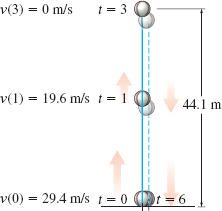EXAMPLE 9Analyzing Vertical Motion
A ball is propelled vertically upward from the ground with an initial velocity of 29.4 meters per second. The height s (in meters) of the ball above the ground is approximately s=s(t)=−4.9t2+29.4t, where t is the number of seconds that elapse from the moment the ball is released.
- (a) What is the velocity of the ball at time t? What is its velocity at t=1second?
- (b) When will the ball reach its maximum height?
- (c) What is the maximum height the ball reaches?
- (d) What is the acceleration of the ball at any time t?
- (e) How long is the ball in the air?
- (f) What is the velocity of the ball upon impact with the ground?
- (g) What is the total distance traveled by the ball?
Solution (a) Since s=−4.9t2+29.4t, then v=v(t)=dsdt=−9.8t+29.4v(1)=−9.8+29.4=19.6
At t=1, the velocity of the ball is 19.6m/s.
180
(b) The ball reaches its maximum height when v(t)=0.v(t)=−9.8t+29.4=09.8t=29.4t=3
The ball reaches its maximum height after 3 seconds.
(c) The maximum height is s=s(3)=−4.9(32)+29.4(3)=44.1
The maximum height of the ball is 44.1 m.
(d) The acceleration of the ball at any time t is a=a(t)=d2sdt2=dvdt=ddt(−9.8t+29.4)=−9.8m/s2
(e) There are two ways to answer the question “How long is the ball in the air?” First way: Since it takes 3s for the ball to reach its maximum altitude, it follows that it will take another 3s to reach the ground, for a total time of 6s in the air. Second way: When the ball reaches the ground, s=s(t)=0. Solve for t: s(t)=−4.9t2+29.4t=0t(−4.9t+29.4)=0t=0ort=29.44.9=6
The ball is at ground level at t=0 and at t=6, so the ball is in the air for 6 seconds.
(f) Upon impact with the ground, t=6s. So the velocity is v(6)=(−9.8)(6)+29.4=−29.4
Upon impact the direction of the ball is downward, and its speed is 29.4m/s.
(g) The total distance traveled by the ball is s(3)+s(3)=2 s(3)=2(44.1)=88.2m
See Figure 25 for an illustration.
